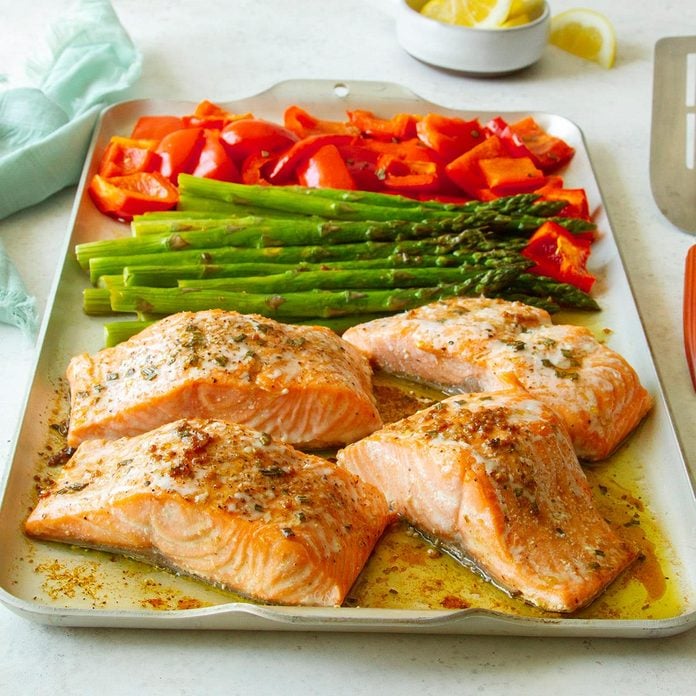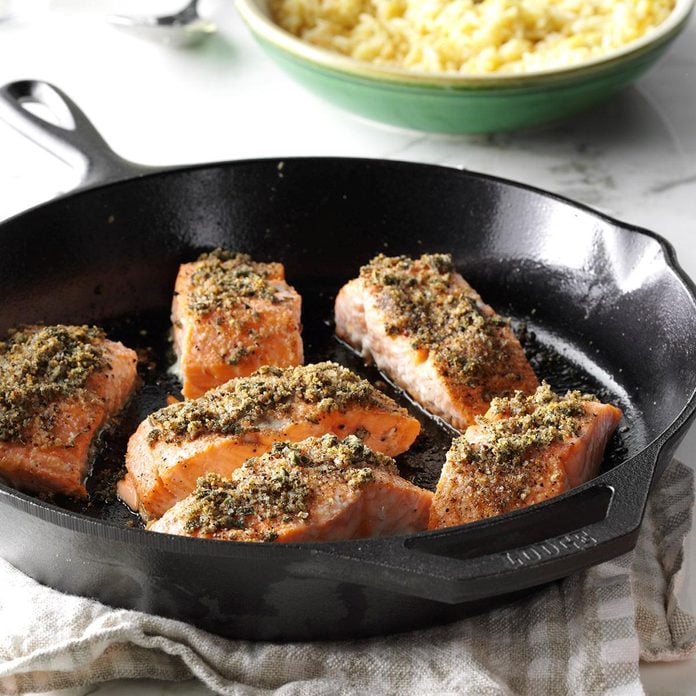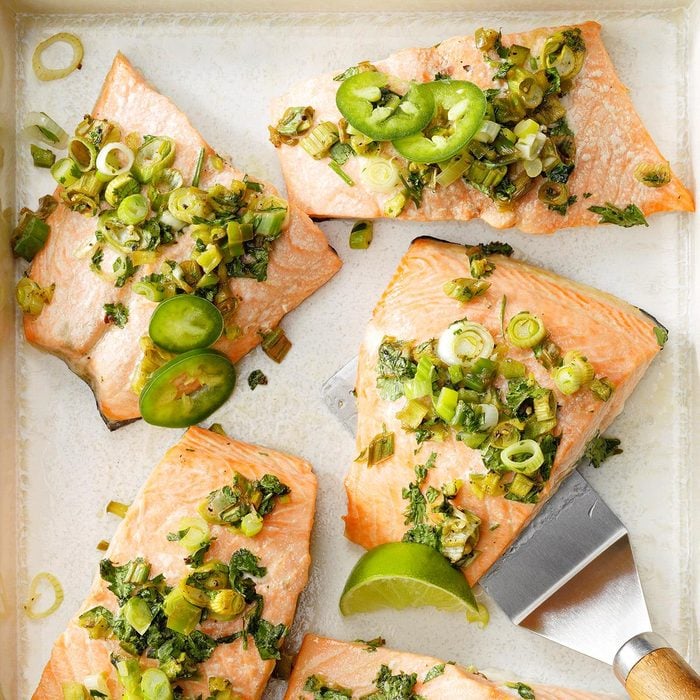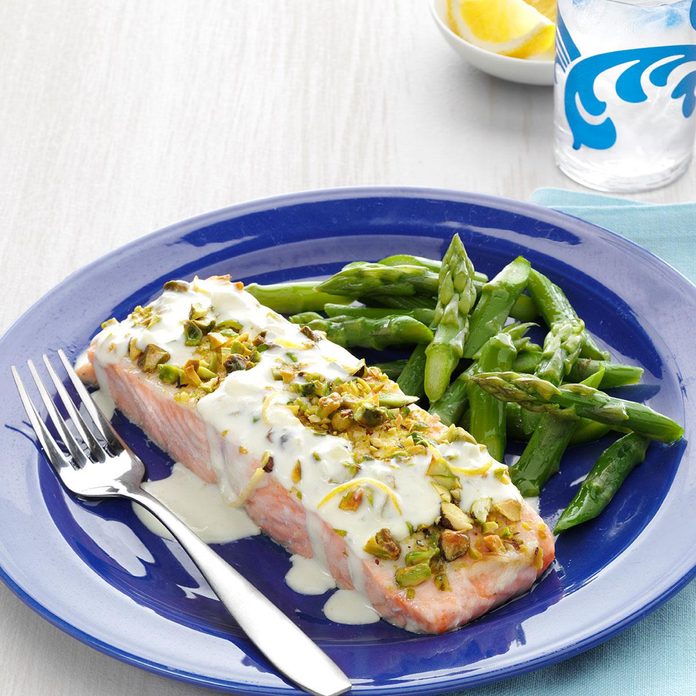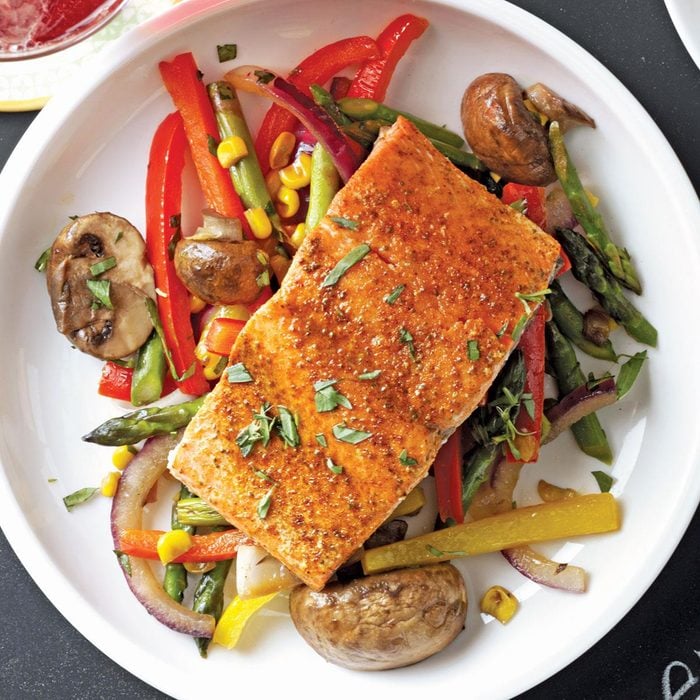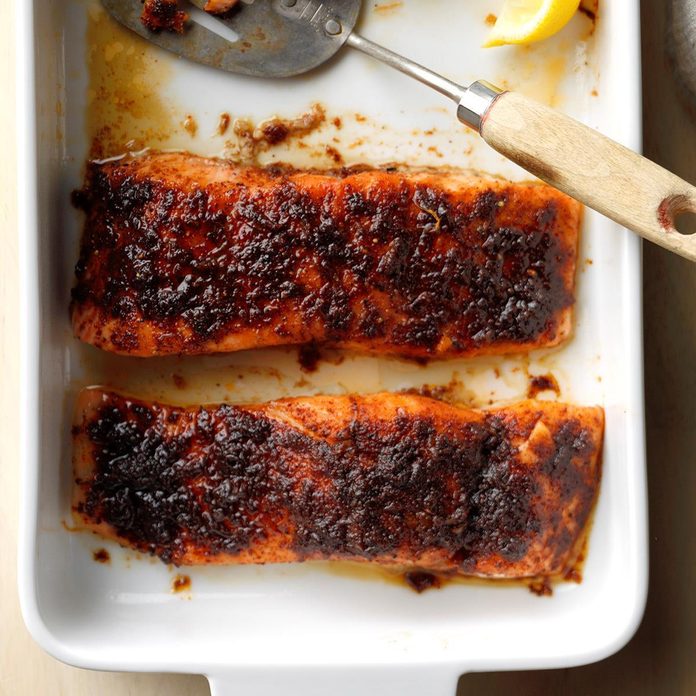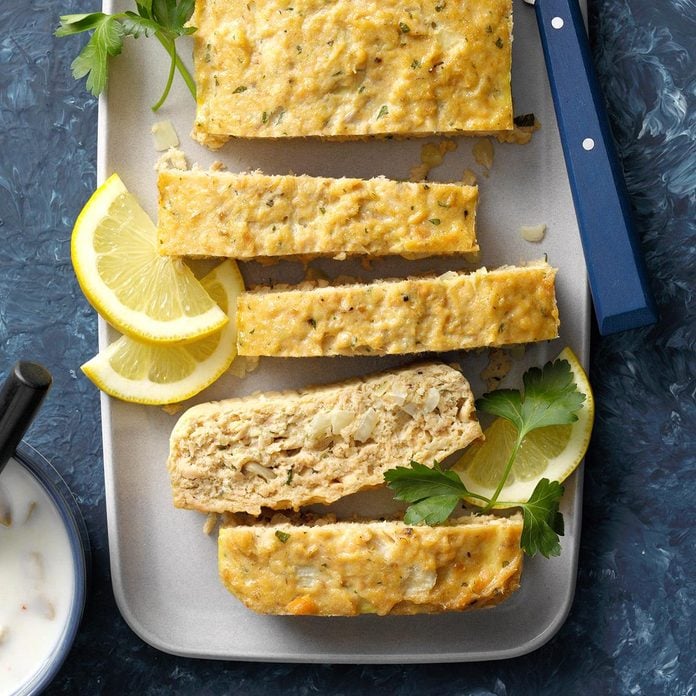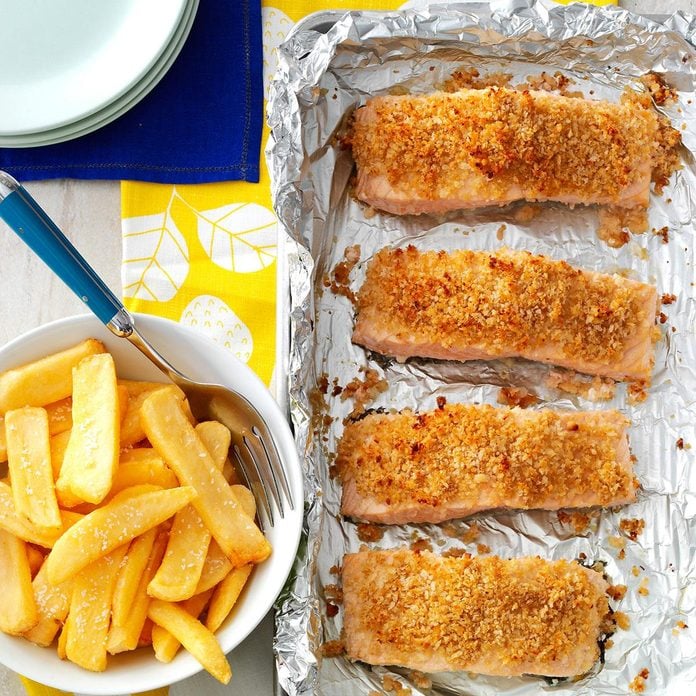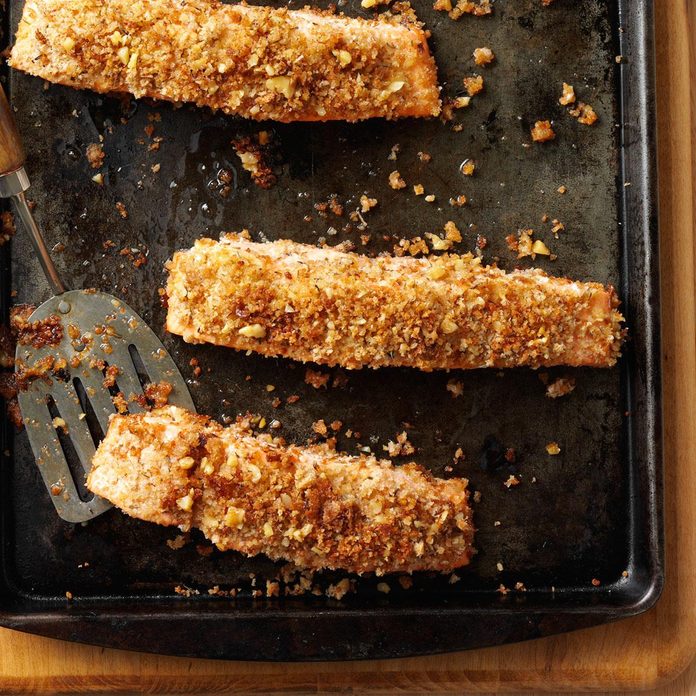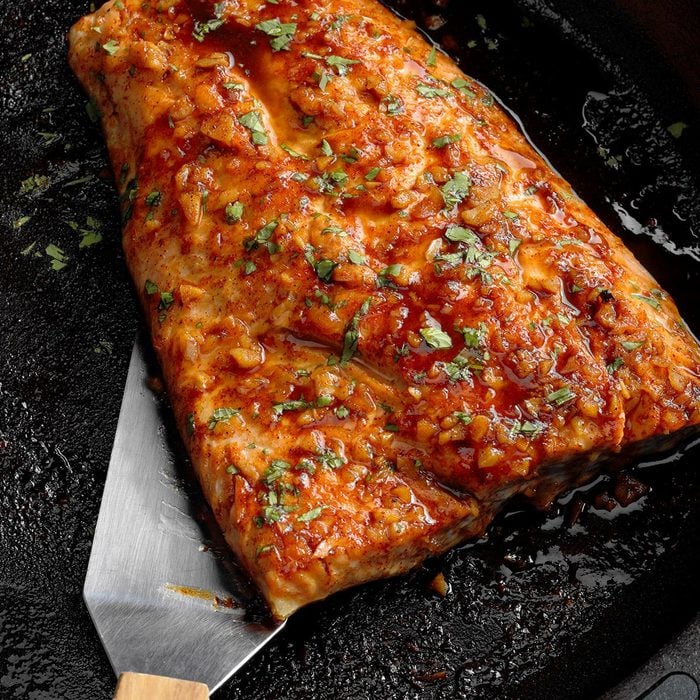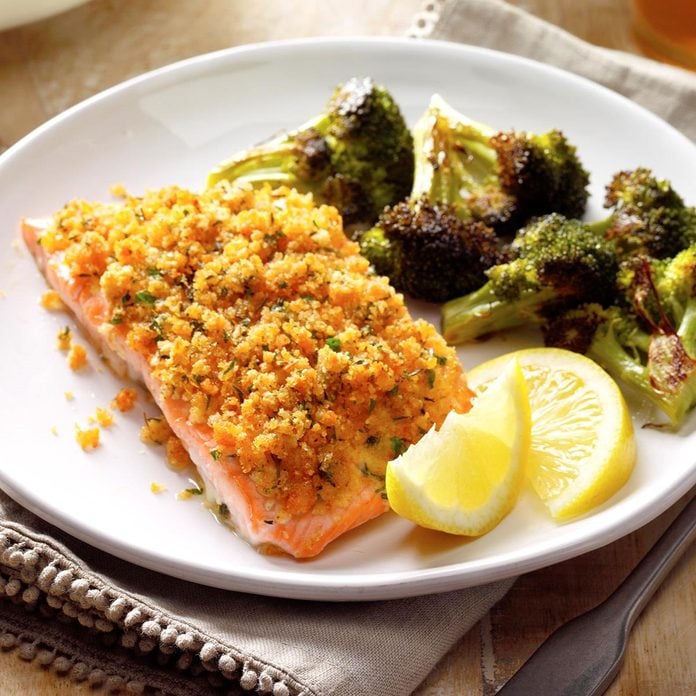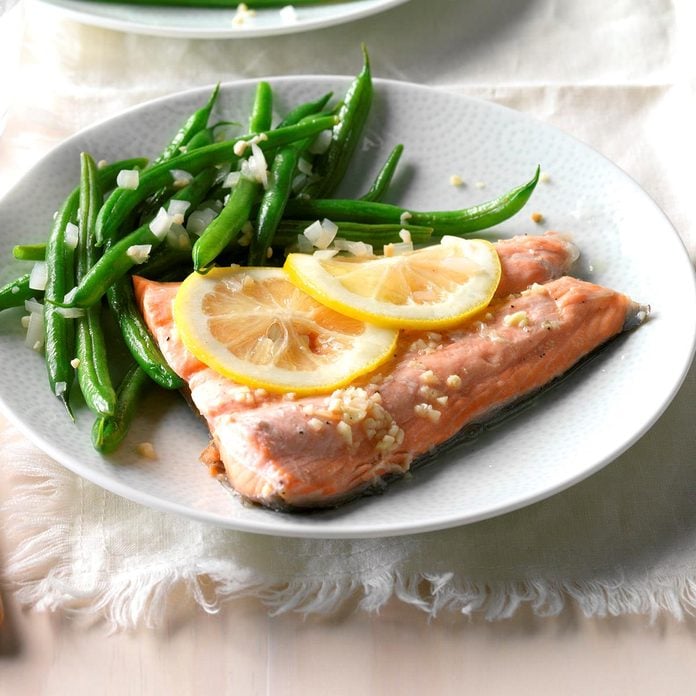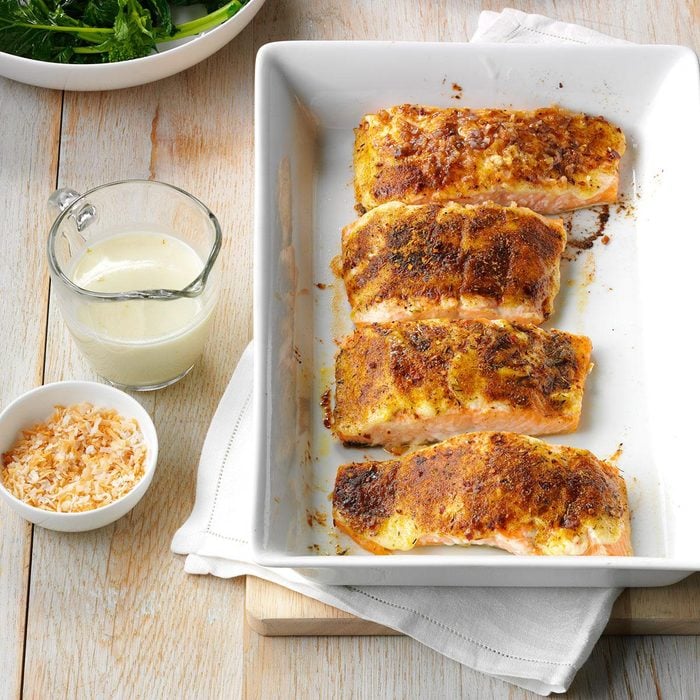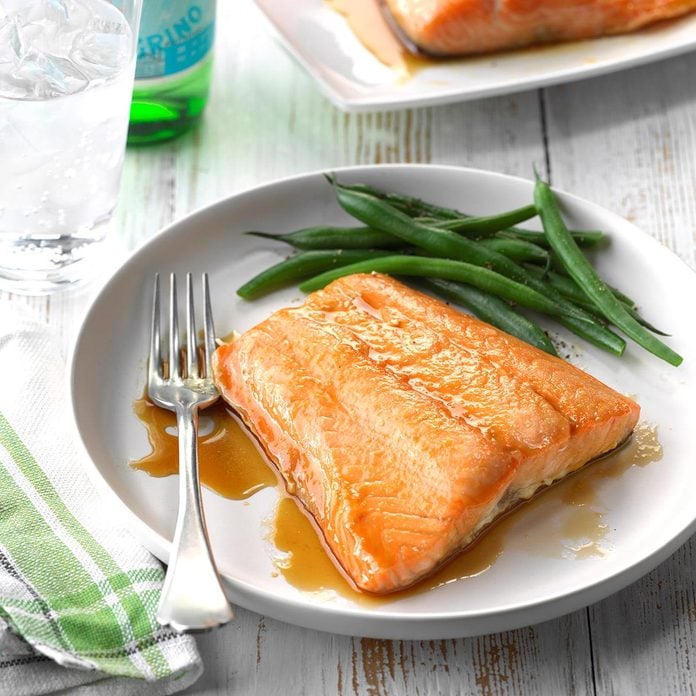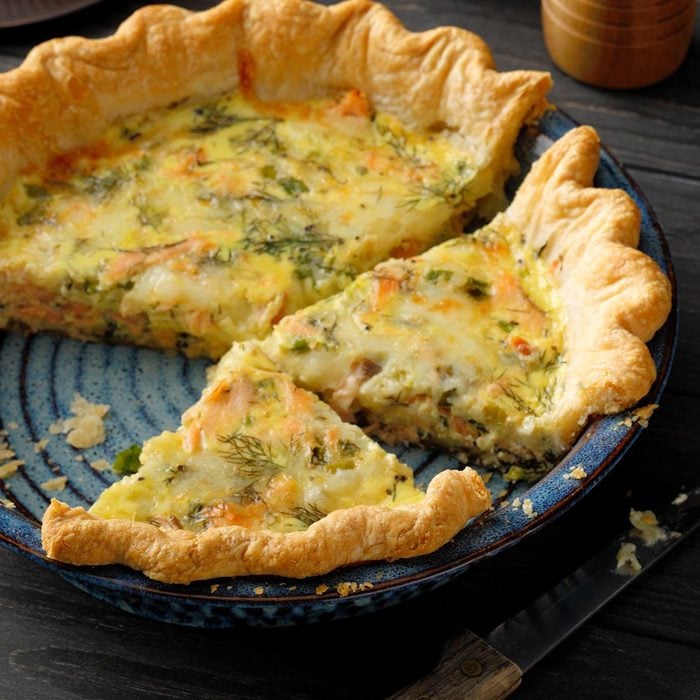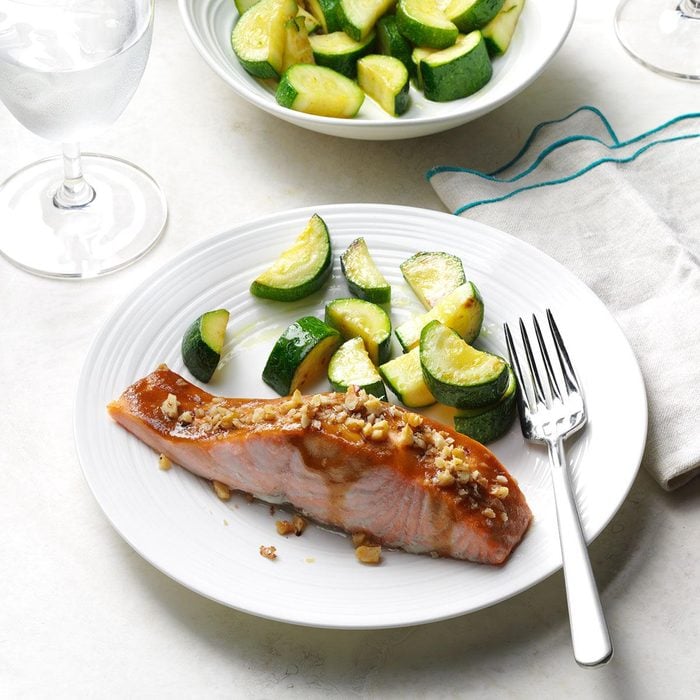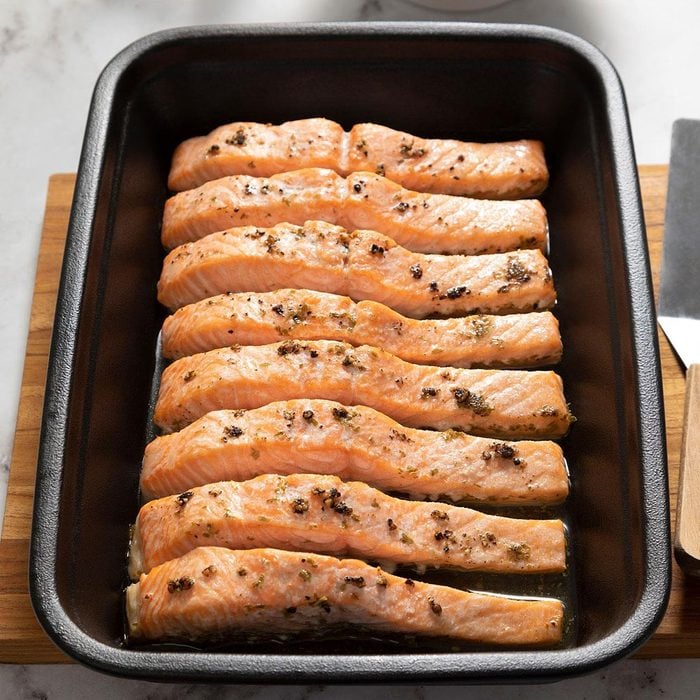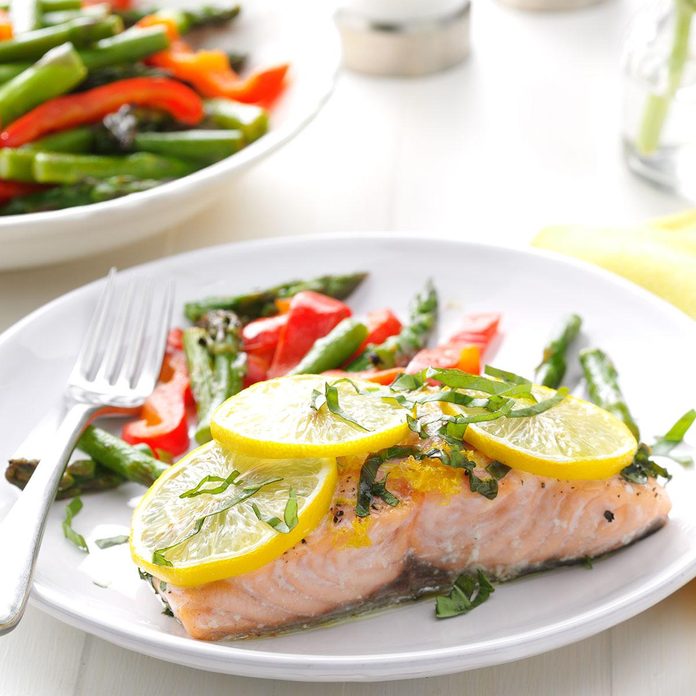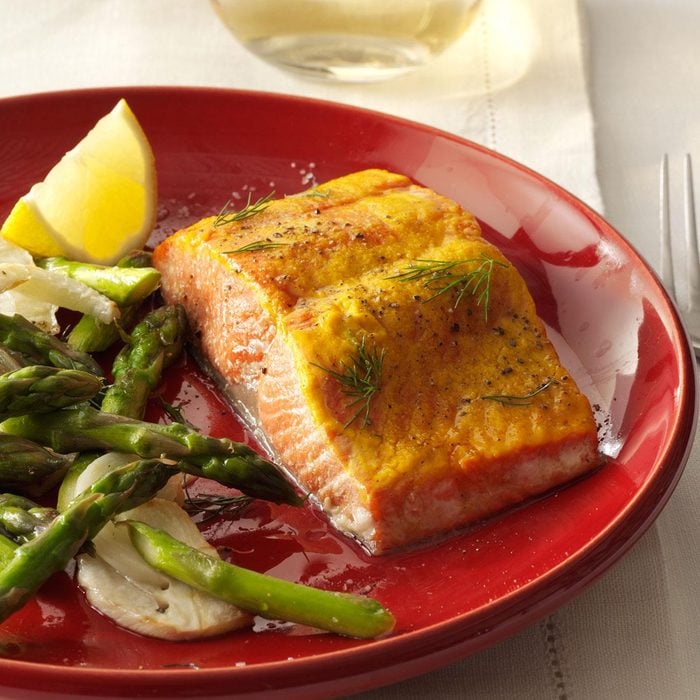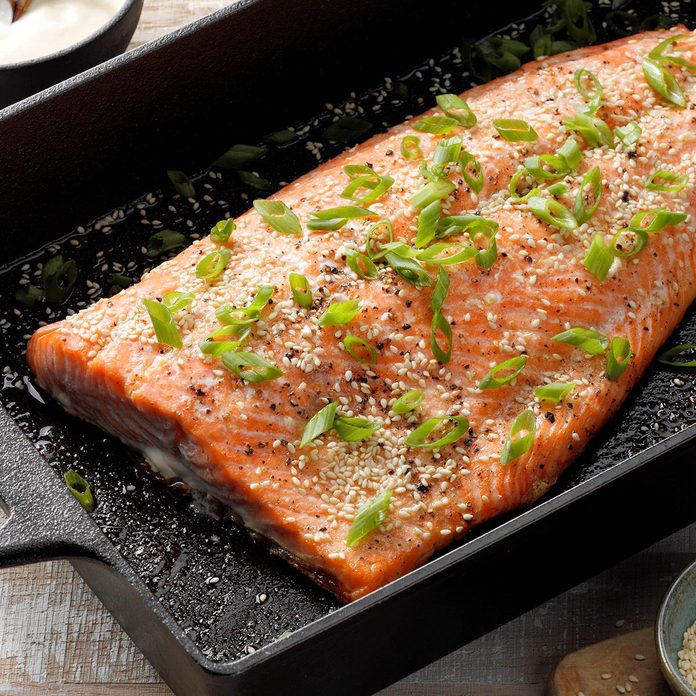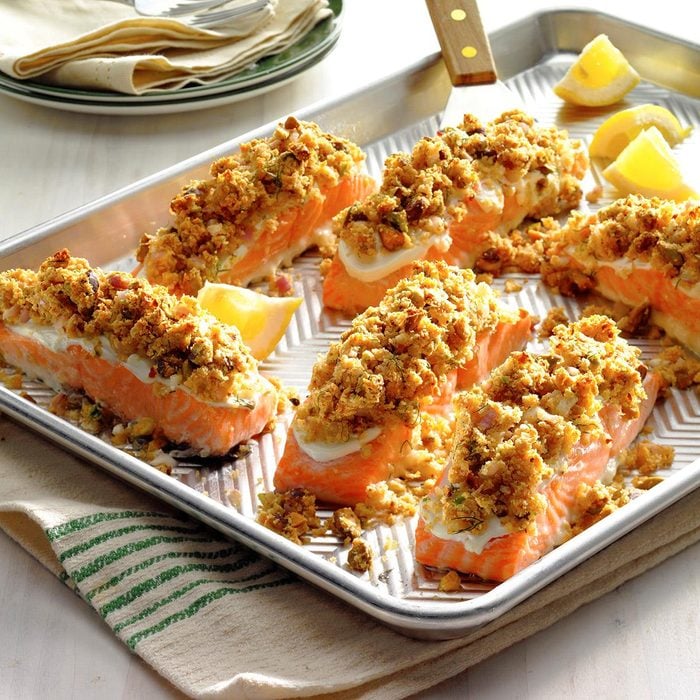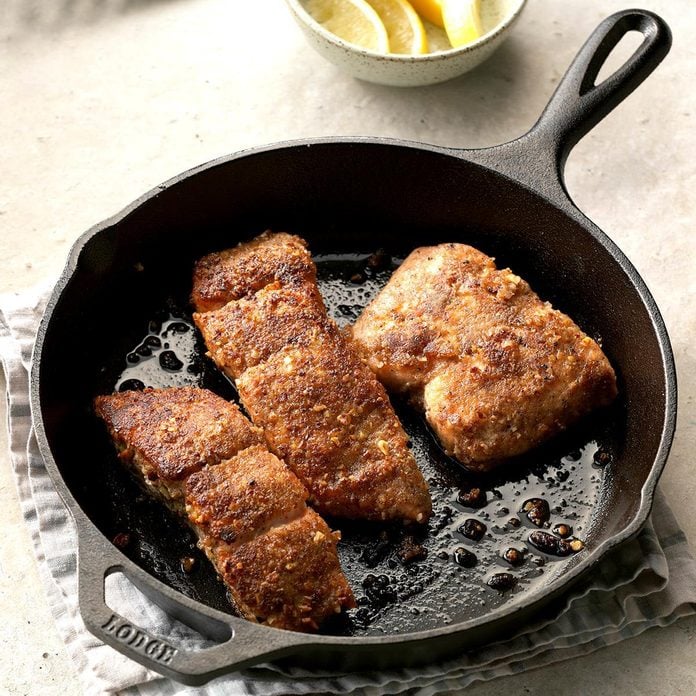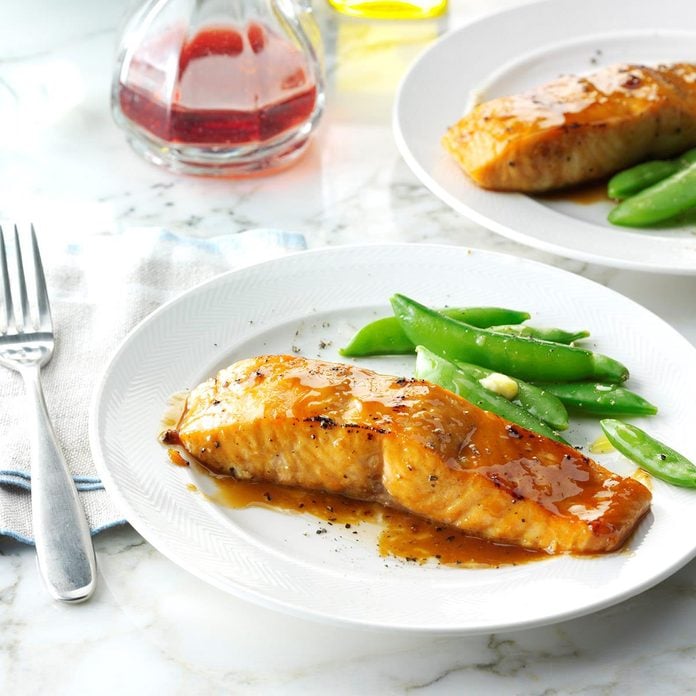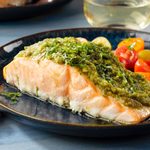Salmon is a fantastic protein for lunch or dinner. Not only is it one of those foods that naturally help lower your blood pressure, but it’s also high in omega-3 fatty acids, which are important for brain health. No wonder you have this fish on your grocery list!
Only seeing skin-on options at the seafood counter, though? Fear not. Here, we’ll list the simple steps for how to remove skin from salmon and highlight an incredibly effective hack.
How to Take the Skin Off of Salmon
If you really hate the idea of removing salmon skin, ask the person working behind the seafood counter to do it for you. Some grocery stores will do this free of charge. If not, follow along with these easy steps.
Step 1: Pat fish dry
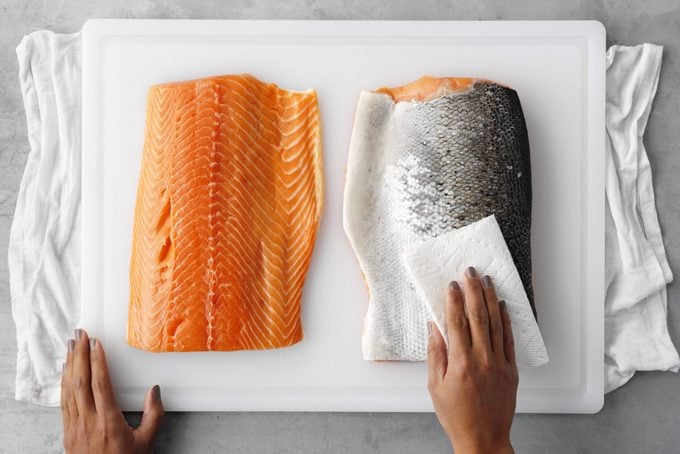 TMB Studio
TMB Studio
Remove the salmon from its packaging and pat it dry with paper towels.
Step 2: Prep on a cutting board
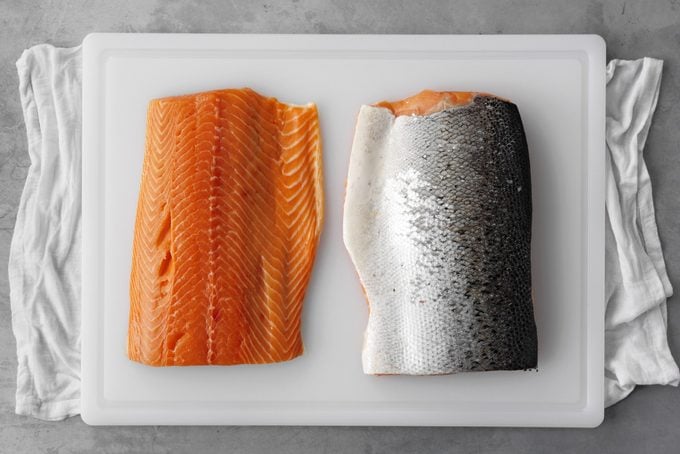 TMB Studio
TMB Studio
Place the salmon on a clean cutting board. If your boards tend to move around a lot, lay a damp dish towel flat on the counter and place your cutting board on top. This should create a slip-proof cutting station.
Step 3: Check for pin bones
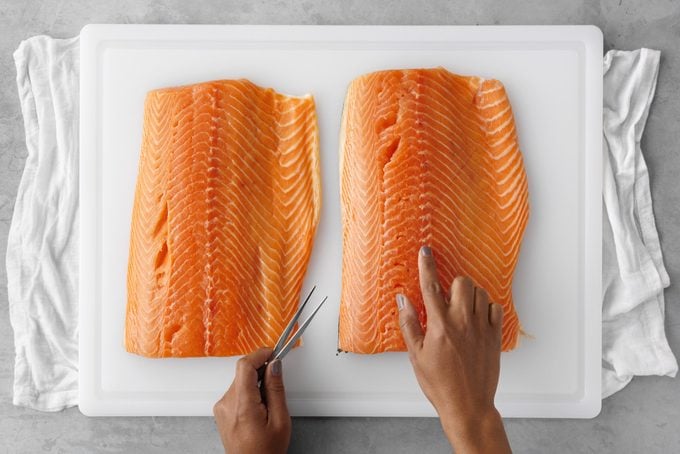 TMB Studio
TMB Studio
This step is more of a precaution. Normally, pin bones will be removed at the grocery store or market where you purchased the fish. Just in case they missed some, take a peek for tiny, opaque bones. If you run your finger along the fillet, you should be able to see the little bones protrude (if there are any).
We used clean tweezers for this step, but you can also use clean needle-nose pliers.
Step 4: Take the skin off the salmon
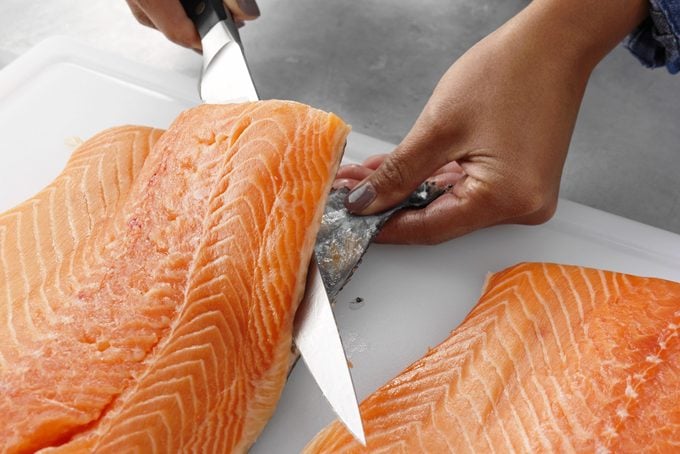 TMB Studio
TMB Studio
At the corner end of the salmon fillet, place a sharp knife between the skin and the flesh. Angle the knife down toward the skin, and slowly slide the knife between the skin and the flesh. Once you’ve cut through about an inch, you can turn the knife so it’s parallel to the cutting board. Grip the skin for leverage, and slide the knife along the skin. This will help keep as much of the fish intact as possible. You shouldn’t see much of the meat coming off with the skin. Discard the skin once it’s removed.
Editor’s Tip: Use any size knife you’re comfortable with. A steak knife or fillet knife works for individual portions of skin-on salmon, while a chef’s knife may be best for a whole salmon fillet.
You can also try out this handy hack from chef and TikTok creator Rose Reisman. It doesn’t even require a knife! You’ll need a baking rack, a baking dish and boiling water. Then, with the salmon positioned on the baking rack with the skin facing up, pour hot water gently onto the fillet. The skin will “shrivel up” and, after around a minute, can be easily pulled away. It’s a simple and effective way to remove salmon skin!
Step 5: Portion out the salmon
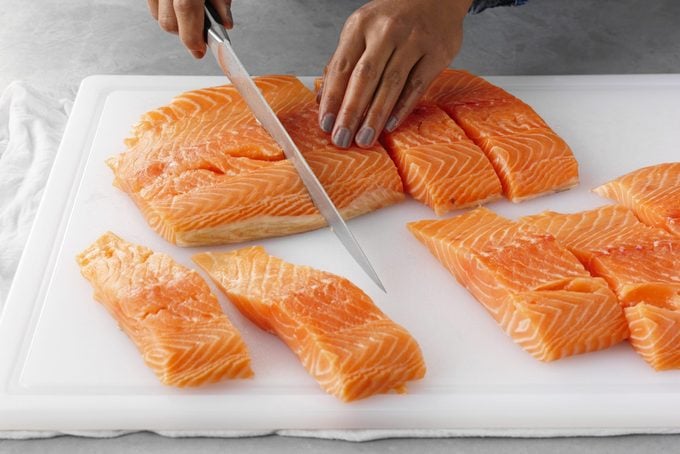 TMB Studio
TMB Studio
If you purchased a large fillet of salmon to cut into single-serve portions, this is when you’ll want to portion it out. It’s easier to slice salmon into smaller servings once the skin has been fully removed. Cut the fish into 4 or 6 oz. fillets, marinate if you choose, cover and refrigerate until ready to cook. Here are a few tips for cooking frozen salmon.
Once cooked, serve the salmon right away. Pair with any of these sides for salmon, like old-fashioned green beans or herbed baked spinach.
FAQs About Cooking Salmon
Can you eat salmon skin?
Yes, salmon skin is edible. If you like a bit of crispy texture in your seafood dishes, it’s totally OK to leave the skin on your salmon.
You’re not eating scales—those are removed before being sold at grocery stores or fish markets. The skin is just the protective outer covering of the fish where the scales grow. Once those scales are gone, however, you’re left with one of the healthiest parts of the salmon. The skin is one of the areas richest in those essential omega-3s.
Is skin-off salmon better than skin-on salmon?
There is no right or wrong answer here. It’s up to you! If you’re not a fan of handling raw fish, absolutely keep the skin on your salmon while you cook it. In fact, leaving the skin on the fish makes it easier to cook when you’re pan-searing salmon or grilling salmon.
If either of these methods is your preferred choice, marinate or season your salmon fillets as normal. Once you’re ready to cook them, oil your pan and place the fish skin-side down. Once the skin crisps up, the skin will make the fish easy to grab with tongs and flip over for the remaining cook time. When the salmon is cooked through, place the fillets on a plate or a clean cutting board. Follow Step 4 above to easily remove the skin.
For poaching or baking salmon, it’s best to take the skin off the salmon before cooking. This will prevent a weird gummy texture that can result from a skin-on fish baking in oil or butter. Here, learn how to bake salmon in foil.
Can you use this method on other types of fish?
Yes! You can use this method to remove the skin from any fish you purchase. Just remember to adjust the size of your knife based on the size of your fish. It will result in the easiest, smoothest cut.
Baked Salmon Recipes We’re Hooked On
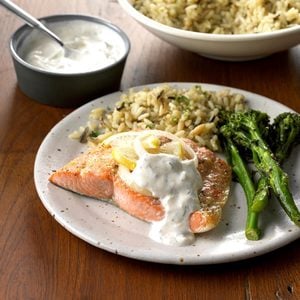 Taste of Home
Taste of Home
There's nothing like fresh salmon, and my mom bakes it just right so it nearly melts in your mouth. The sour cream dill sauce is subtly seasoned with horseradish so that it doesn't overpower the delicate salmon flavor. —Susan Emery, Everett, Washington
Go to Recipe
Rosemary Salmon and VeggiesMy husband and I eat a lot of salmon. One night, while in a rush to get dinner on the table, I created this rosemary salmon meal. It's a keeper! You can also include sliced zucchini, small cauliflower florets or fresh green beans. —Elizabeth Bramkamp, Gig Harbor, Washington
Sage-Rubbed SalmonIf you’ve always thought of sage with turkey, try it with salmon for a little taste of heaven. We serve this with rice, salad and sauteed green beans. You can also crack open a nice bottle of
wine that pairs with salmon. —Nicole Raskopf, Beacon, New York
Cilantro-Topped SalmonThis cilantro lime salmon has been a favorite with everyone who's tried it. A bright and fresh cilantro-lime sauce complements tender salmon fillets in this entree. —Nancy Culbert, Whitehorn, California
Pistachio-Crusted Salmon with Lemon Cream SauceNutty pistachios add color and crunch when sprinkled on fish. The cream sauce gives this baked salmon dish a lemony smooth finish. —Ann Baker, Texarkana, Texas
Lemon-Lime Salmon with Veggie SauteA fresh squeeze of lemon juice brightens so many flavors—acid is one of the most important influencers in how a dish tastes. If one acid is good, two is stronger: add lemon and lime juice when you bake salmon, cooking the supporting cast of vegetables separately until crisp-tender. —Brian Hill, West Hollywood, California
Sensational Spiced SalmonA bold rub gives this quick seafood entree fantastic flavor. Paired with a green veggie and rice, my spicy salmon is a delightful weeknight dinner that’s special enough for company. —Michele Doucette, Stephenville, Newfoundland and Labrador
Salmon LoafDuring the Depression, Mom's tasty salmon loaf was a welcome change from the usual meat loaf everyone made to stretch a meal. I still like a lot of the make-do meals of those days, but this loaf is one of my favorites. If you're looking for more recipes, then try our favorite baked
pesto salmon.
Crispy Fish & ChipsA British pub classic turns crown jewel when you add horseradish, panko and Worcestershire. You can also try it with white fish like cod or haddock. —Linda Schend, Kenosha, Wisconsin
Walnut-Crusted SalmonWhenever I can get salmon for a good price, I always turn to this simple and delicious baked salmon recipe. It’s good served with mashed potatoes and fresh green beans, too. —Edie DeSpain, Logan, Utah
Scrumptious California SalmonCalifornia cuisine is all about balancing flavors. This baked salmon recipe brings out the sweetness in orange juice and honey and balances it with the kick of ancho chili pepper and balsamic. —Dustin Anderson, Fillmore, California
Crumb-Topped SalmonOften we catch enough of our delicious Northwest salmon to send some to Michigan for my sister to enjoy. This crisp, lemony recipe is a tasty way to enjoy it. —Perlene Hoekema, Lynden, Washington
If you can't catch your own, here's the
best salmon to buy.
Ginger Salmon with Green BeansI developed this flavor-packed dinner for a busy friend who wants to eat clean. This baked salmon recipe quickly become one of their favorites! —Nicole Stevens, Austin, Texas
Jamaican-Style Salmon with Coconut Cream SauceWe try to eat salmon a lot because it's so healthy, and I love thinking of new ways to make it different and delicious. This dazzling baked salmon recipe is my go-to meal for company. —Joni Hilton, Rocklin, California
Easy Glazed SalmonIt only takes four ingredients and a few moments of time to make this delightful main dish. This baked salmon recipe will quickly make its way into your dinner rotation. —Tara Ernspiker, Falling Waters, West Virginia
Finnish Salmon and Dill PieBeing of Finnish heritage, I am always thrilled when I find a family recipe. This salmon and dill pie came tumbling out of one of my grandmother's books. It will be a winner at any of your social functions. —Judy Batson, Tampa, Florida
Walnut-Crusted Ginger SalmonFor those who aren’t wild about fish, this gingery salmon is a game-changer. Baking on foil makes for extra-easy cleanup. —Becky Walch, Orland, California
Baked SalmonI often make this very moist and flavorful dinner for company because I can have it ready in less than half an hour. This baked salmon recipe with lemon is well complemented by rice or a green vegetable and a tossed salad. —Emily Chaney, Penobscot, Maine
Lemon Salmon with BasilAt our house we opt for healthy foods, and this lemony salmon with basil is a knockout in the good-for-you category. We have it with asparagus or zucchini. —Shanna Belz, Prineville, Oregon
Sweet Mustard SalmonLemon juice, mustard and brown sugar add something special to this salmon dish. You'll find yourself coming back to this baked salmon recipe. —Cortney Claeson, Spokane, Washington
Sesame Salmon with Wasabi MayoI created this baked salmon recipe to mimic the flavors of sushi. It’s remarkably simple and turns out well every time. —Carolyn Ketchum, Wakefield, Massachusetts
Salmon with Horseradish Pistachio CrustImpress everyone at your table with this elegant but easy salmon that's delicious and nutritious. You can substitute scallions for shallots if you like. —Linda Press Wolfe, Cross River, New York
Crusted SalmonThese delicious salmon fillets are wonderful for company since they take only a few minutes to prepare, yet they taste like you fussed. I receive requests for the recipe every time I serve them.
Brown Sugar-Glazed SalmonPop these protein-packed salmon fillets in the oven before whipping up a sweet basting sauce. This tangy entree cooks up in minutes making it a perfect meal for busy families and unexpected weekend guests. —Debra Martin, Belleville, Michigan
Salmon QuicheThis recipe came to me from my mother—it’s the kind you request after just one bite! Unlike some quiches, this one is hearty enough to appeal to both big and small appetites. —Deanna Baldwin, Bermuda Dunes, California







